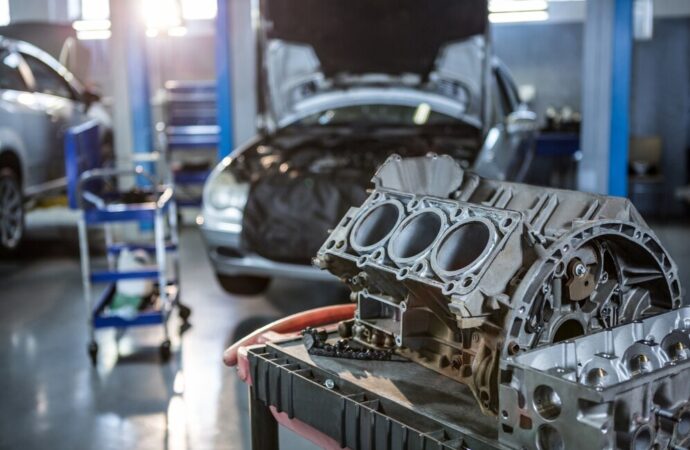Ever wonder how your car effortlessly shifts speeds? The secret lies in a major component known as the gearbox. It is responsible for adjusting torque and speed seamlessly. In this post, we’ll examine the mechanics of a car gearbox, its functionality, and the various types commonly found in vehicles. What Is a Car Gearbox? A
Ever wonder how your car effortlessly shifts speeds? The secret lies in a major component known as the gearbox. It is responsible for adjusting torque and speed seamlessly. In this post, we’ll examine the mechanics of a car gearbox, its functionality, and the various types commonly found in vehicles.
What Is a Car Gearbox?
A gearbox, often called a transmission, is a mechanical device that helps channel power from the engine to the wheels through different gear ratios. It is positioned between the engine and the wheels. It includes an array of gears, shafts, and bearings. It is connected to the engine’s crankshaft via a clutch; this linkage lets the engine and gearbox momentarily disconnect during gear shifts. Its main objective is distributing the correct power and torque to the wheels for maximum efficiency and performance at different speeds.
Parts of a Car Gearbox
Here’s a simple breakdown of the main parts of a gearbox:
Clutch Shaft: It is like the messenger from the engine. It takes power from the engine and sends it to other parts. The clutch connects it to the engine and makes it spin when you use the clutch.
Counter Shaft: This part has many gears of different sizes. It helps give the car the push it needs to move.
Main Shaft: Think of it as the primary worker. It provides the force the car needs to move. Its particular patterns make the gears slide easily.
Bearings: These help the parts spin without much rubbing.
Gears: They’re like hands passing power from one part to another. The strength they pass depends on their patterns and size.
Different Types of Gearboxes in Cars
There are two main types of car gearboxes: manual and automatic. Automatic car gearboxes include Torque Converter, CVT (Continuously Variable Transmission), AMT (Automatic Manual Transmission), and DCT (Dual Clutch Transmission). Let’s take a closer look at these car transmission types.
Manual Gearbox
A manual gearbox gives drivers complete control, letting them select gears using the gearstick and clutch. Manual transmissions are cheaper and simpler to look after than automatic ones. The manual option is popular in cars mainly because of its cost-effectiveness and ease of maintenance.
Automatic Gearbox
An automatic gearbox shifts gears independently, eliminating the need for manual shifting. It relies on electronic sensors to gauge the car’s speed, with an Electronic Control Unit (ECU) assisting in gear changes. While automatic gearboxes offer more convenience than manual ones, they tend to be more complex and expensive to maintain. Now, let’s look into the various kinds of car automatic transmissions.
Automated Manual Transmission (AMT)
The AMT gearbox modernizes the manual system using hydraulics to control the clutch pedal. Instead of physically operating the clutch and gears, electronic sensors in the AMT handle the job. This gearbox type has reshaped the car market by introducing budget-friendly automatic options. Its standout feature is its cost-efficiency; fewer parts than full-automatic gearboxes bring down the vehicle’s price.
Torque Converter Gearbox
The Torque Converter Gearbox is a unique type of automatic transmission that uses fluid coupling to relay power from the engine to the wheels. Unlike other automatic systems, it doesn’t need a clutch pedal for gear shifts. Historically, the torque converter was a common choice among gearboxes. However, its appeal has diminished recently because of its relatively lower fuel efficiency and higher maintenance expenses. Yet, it remains an option worth considering for those valuing smoothness in gear transitions and immediate power delivery.
Continuously Variable Transmission (CVT)
The CVT (Continuously Variable Transmission) gearbox is a unique automatic system with a pulley mechanism. Rather than relying on fixed gears, it uses sophisticated components to transition between a continuum of gear ratios. The system is built around cones attached to each pulley, linked by a belt. By adjusting the diameter of the chain belt, the gear ratios are altered seamlessly. The CVT shines in its reliability and remarkable fuel efficiency. While its innovative approach to transmission can be found in various car brands, it is particularly prevalent in Japanese vehicles, such as those from Honda, Nissan, and Toyota, underlining their commitment to both performance and economy.
Dual Clutch Transmission (DCT)
The DCT, or Dual Clutch Transmission, operates with two clutches to facilitate swift gear changes, ensuring top-notch performance. It dedicates one clutch to odd-numbered gears and the other to even-numbered ones, effectively diminishing the delay during shifts. This setup enables rapid and fluid gear transitions in contrast to conventional transmissions. When one clutch is active and supplying power, the other pre-arranged the upcoming gear, paving the way for swifter shifts. Initially favored in high-performance and sports vehicles, the DCT is now gaining traction in the general car market.
Functions of the Car Gearbox
Here are some of the functions of the car gearbox:
Adjusting Gear Ratios: The gearbox tweaks the gear ratio to suit various driving scenarios. Drivers can manually alter this ratio based on speed and road conditions.
Powering the Wheels: The gearbox ensures the engine’s power reaches the wheels at varying speeds, refining fuel efficiency and driving performance.
Regulating Speed: The gearbox allows drivers to control the vehicle’s pace, either decelerating or accelerating, by selecting the right gear.
Amplifying Torque: The gearbox enhances the engine’s torque, supplying added power to the wheels and enabling the vehicle to drive through steep inclines.
How Does a Car Gearbox Work?
A car’s gearbox acts as a mediator, channeling the engine’s power to propel the wheels using an array of gears. These gears are structured in specific configurations to deliver varied speeds without compromising engine efficiency. A lever or electronic selector inside the car allows drivers to pick the appropriate gear. In vehicles with a manual transmission, drivers manually maneuver this gear lever or selector. However, the system leverages electronic sensors in cars with automatic transmissions to adapt gears according to the car’s speed and workload.
Interesting Facts About Car Gearboxes
Here are some fascinating facts about car gearboxes.
- Automatic gearboxes are more familiar than you might think. As early as the 1930s, General Motors (GM) was ahead of the game, launching the HydraMatic gearbox in their Cadillac and Oldsmobile lines.
- Gone are the days when manual gearboxes were the sole champions of fuel efficiency. Nowadays, automatic transmissions can match and sometimes even surpass their fuel-saving capabilities.
- The world of automatic transmissions is diverse, with several types.
- Despite advancements, manual transmissions generally remain more budget-friendly than their automatic counterparts.


















Leave a Comment
Your email address will not be published. Required fields are marked with *